Table of contents
- 1. Introduction to Biology2h 42m
- 2. Chemistry3h 40m
- 3. Water1h 26m
- 4. Biomolecules2h 23m
- 5. Cell Components2h 26m
- 6. The Membrane2h 31m
- 7. Energy and Metabolism2h 0m
- 8. Respiration2h 40m
- 9. Photosynthesis2h 49m
- 10. Cell Signaling59m
- 11. Cell Division2h 47m
- 12. Meiosis2h 0m
- 13. Mendelian Genetics4h 44m
- Introduction to Mendel's Experiments7m
- Genotype vs. Phenotype17m
- Punnett Squares13m
- Mendel's Experiments26m
- Mendel's Laws18m
- Monohybrid Crosses19m
- Test Crosses14m
- Dihybrid Crosses20m
- Punnett Square Probability26m
- Incomplete Dominance vs. Codominance20m
- Epistasis7m
- Non-Mendelian Genetics12m
- Pedigrees6m
- Autosomal Inheritance21m
- Sex-Linked Inheritance43m
- X-Inactivation9m
- 14. DNA Synthesis2h 27m
- 15. Gene Expression3h 20m
- 16. Regulation of Expression3h 31m
- Introduction to Regulation of Gene Expression13m
- Prokaryotic Gene Regulation via Operons27m
- The Lac Operon21m
- Glucose's Impact on Lac Operon25m
- The Trp Operon20m
- Review of the Lac Operon & Trp Operon11m
- Introduction to Eukaryotic Gene Regulation9m
- Eukaryotic Chromatin Modifications16m
- Eukaryotic Transcriptional Control22m
- Eukaryotic Post-Transcriptional Regulation28m
- Eukaryotic Post-Translational Regulation13m
- 17. Viruses37m
- 18. Biotechnology2h 58m
- 19. Genomics17m
- 20. Development1h 5m
- 21. Evolution3h 1m
- 22. Evolution of Populations3h 52m
- 23. Speciation1h 37m
- 24. History of Life on Earth2h 6m
- 25. Phylogeny2h 31m
- 26. Prokaryotes4h 59m
- 27. Protists1h 12m
- 28. Plants1h 22m
- 29. Fungi36m
- 30. Overview of Animals34m
- 31. Invertebrates1h 2m
- 32. Vertebrates50m
- 33. Plant Anatomy1h 3m
- 34. Vascular Plant Transport1h 2m
- 35. Soil37m
- 36. Plant Reproduction47m
- 37. Plant Sensation and Response1h 9m
- 38. Animal Form and Function1h 19m
- 39. Digestive System1h 10m
- 40. Circulatory System1h 57m
- 41. Immune System1h 12m
- 42. Osmoregulation and Excretion50m
- 43. Endocrine System1h 4m
- 44. Animal Reproduction1h 2m
- 45. Nervous System1h 55m
- 46. Sensory Systems46m
- 47. Muscle Systems23m
- 48. Ecology3h 11m
- Introduction to Ecology20m
- Biogeography14m
- Earth's Climate Patterns50m
- Introduction to Terrestrial Biomes10m
- Terrestrial Biomes: Near Equator13m
- Terrestrial Biomes: Temperate Regions10m
- Terrestrial Biomes: Northern Regions15m
- Introduction to Aquatic Biomes27m
- Freshwater Aquatic Biomes14m
- Marine Aquatic Biomes13m
- 49. Animal Behavior28m
- 50. Population Ecology3h 41m
- Introduction to Population Ecology28m
- Population Sampling Methods23m
- Life History12m
- Population Demography17m
- Factors Limiting Population Growth14m
- Introduction to Population Growth Models22m
- Linear Population Growth6m
- Exponential Population Growth29m
- Logistic Population Growth32m
- r/K Selection10m
- The Human Population22m
- 51. Community Ecology2h 46m
- Introduction to Community Ecology2m
- Introduction to Community Interactions9m
- Community Interactions: Competition (-/-)38m
- Community Interactions: Exploitation (+/-)23m
- Community Interactions: Mutualism (+/+) & Commensalism (+/0)9m
- Community Structure35m
- Community Dynamics26m
- Geographic Impact on Communities21m
- 52. Ecosystems2h 36m
- 53. Conservation Biology24m
18. Biotechnology
Steps to DNA Cloning
Problem 2`
Textbook Question
What is a plasmid?
a. An organelle found in many bacteria and certain eukaryotes
b. A circular DNA molecule that replicates independently of the main chromosome(s)
c. A type of virus that has a DNA genome and infects certain types of human cells, including lung and respiratory tract tissue
d. A type of virus that has an RNA genome, codes for reverse transcriptase, and inserts a cDNA copy of its genome into cells
 Verified step by step guidance
Verified step by step guidance1
Understand that a plasmid is a genetic structure in cells, often used in molecular biology.
Recognize that plasmids are typically found in bacteria, but can also be present in some eukaryotes.
Identify that plasmids are distinct from the main chromosomal DNA, as they are usually circular and can replicate independently.
Note that plasmids are not viruses, so options describing viral characteristics (such as options c and d) are not correct.
Conclude that the correct description of a plasmid is option b: a circular DNA molecule that replicates independently of the main chromosome(s).
 Verified video answer for a similar problem:
Verified video answer for a similar problem:This video solution was recommended by our tutors as helpful for the problem above
Video duration:
46sPlay a video:
Was this helpful?
Key Concepts
Here are the essential concepts you must grasp in order to answer the question correctly.
Plasmid
A plasmid is a small, circular DNA molecule found in bacteria and some eukaryotes that replicates independently of the chromosomal DNA. Plasmids often carry genes that confer advantageous traits, such as antibiotic resistance, and are used in genetic engineering due to their ability to transfer genes between cells.
Recommended video:
Guided course
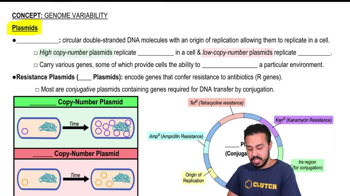
Plasmids
Independent Replication
Independent replication refers to the ability of plasmids to replicate autonomously within a host cell, separate from the chromosomal DNA. This characteristic allows plasmids to be maintained in multiple copies within a cell, facilitating the spread of genetic traits and their use in molecular cloning.
Recommended video:
Guided course
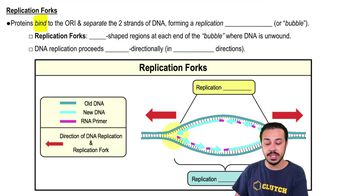
Replication Forks
Genetic Engineering
Genetic engineering involves the manipulation of an organism's genome using biotechnology. Plasmids are crucial tools in this process, as they can be engineered to carry specific genes and introduced into host cells to study gene function, produce proteins, or develop genetically modified organisms.
Recommended video:
Guided course

Genetic Code
Related Videos
Related Practice







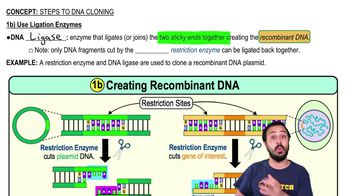
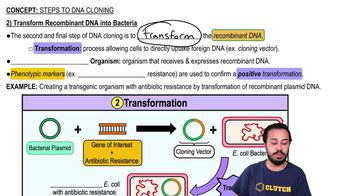
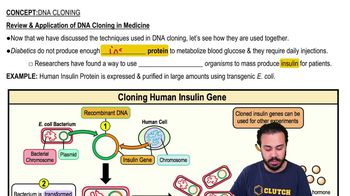





![[LECT C8 : RECOMBINANT DNA TECHNOLOGY] 8.2 Steps in Gene Cloning](https://img.youtube.com/vi/T1l-StLrDwg/mqdefault.jpg)

